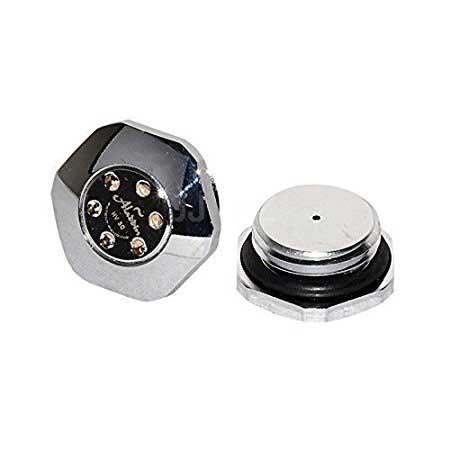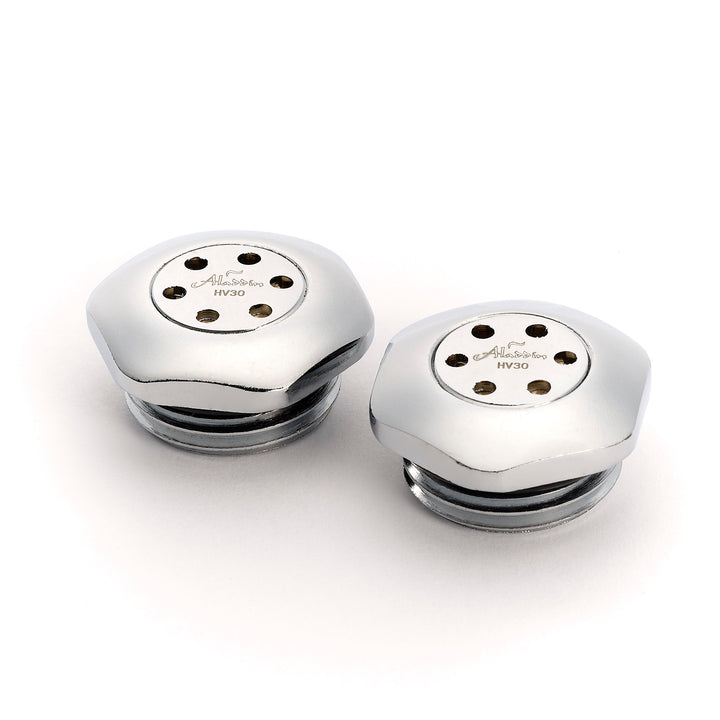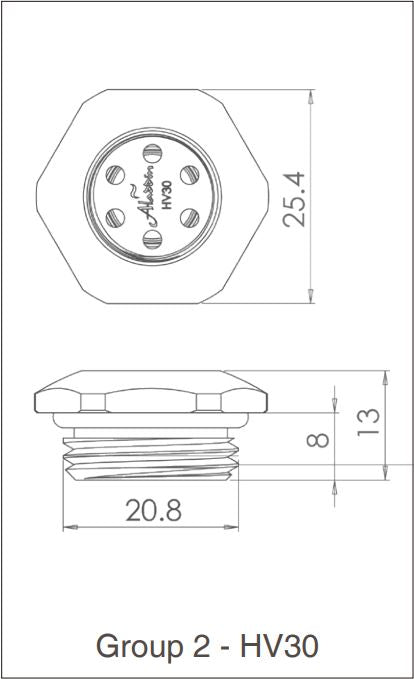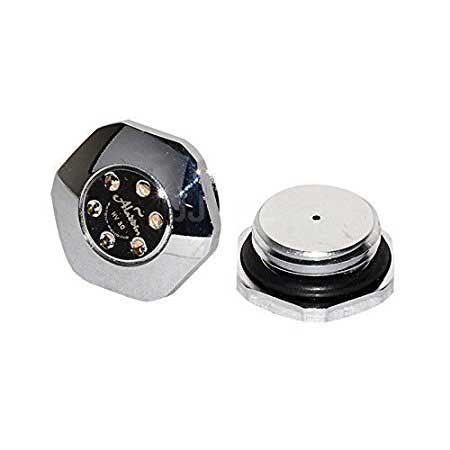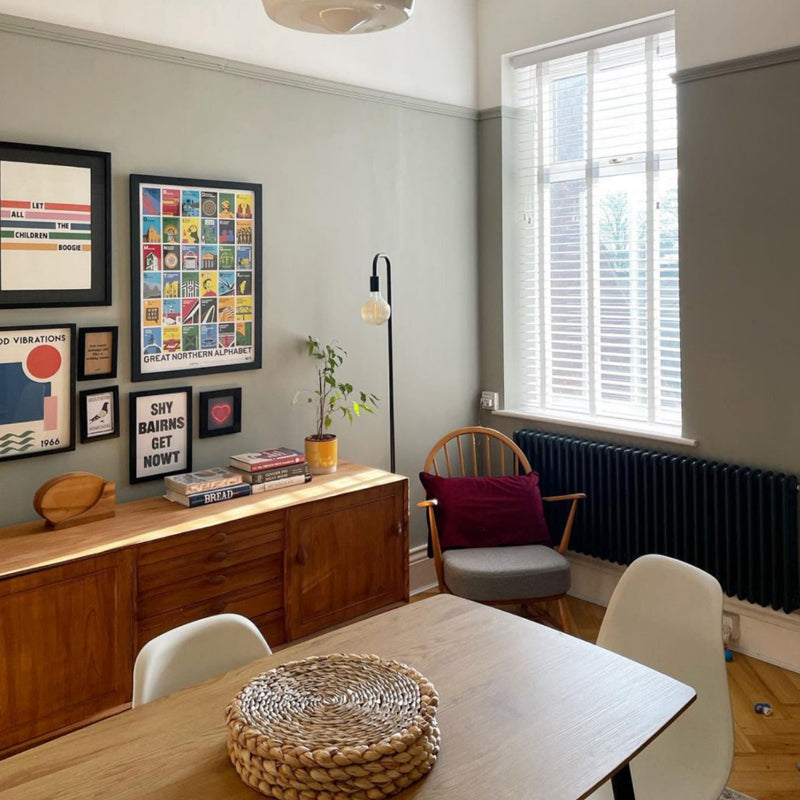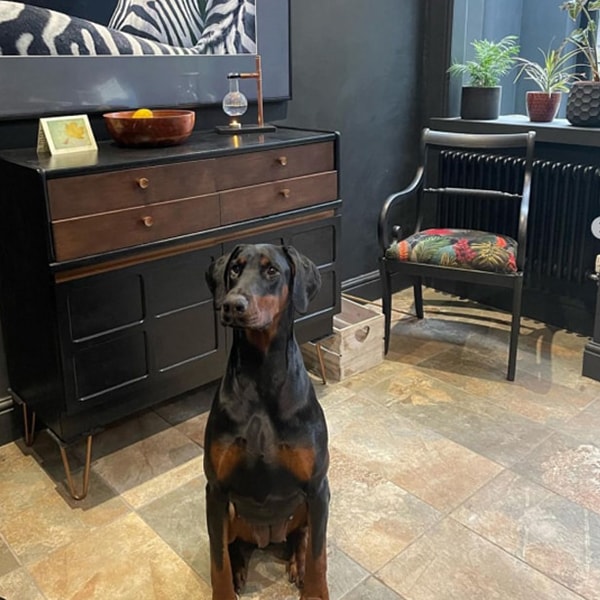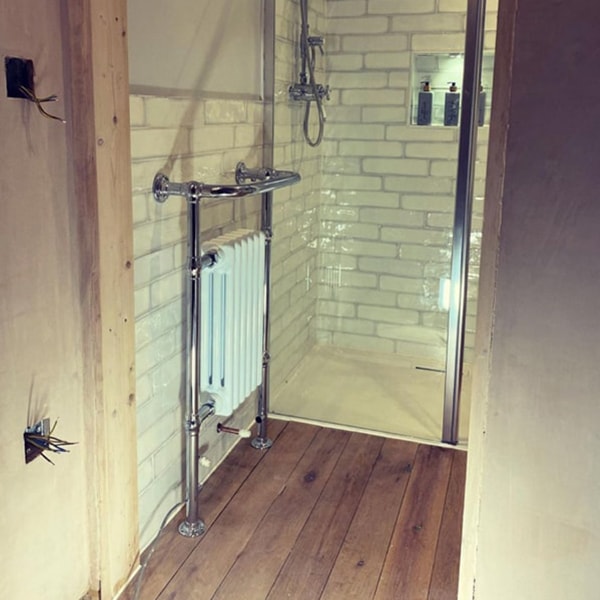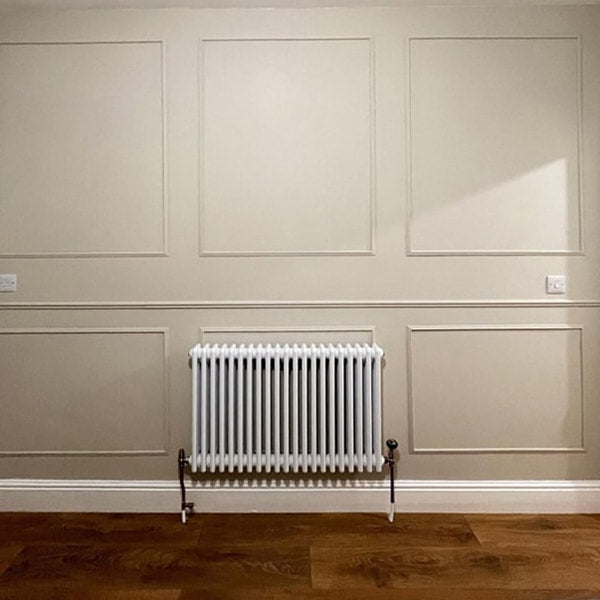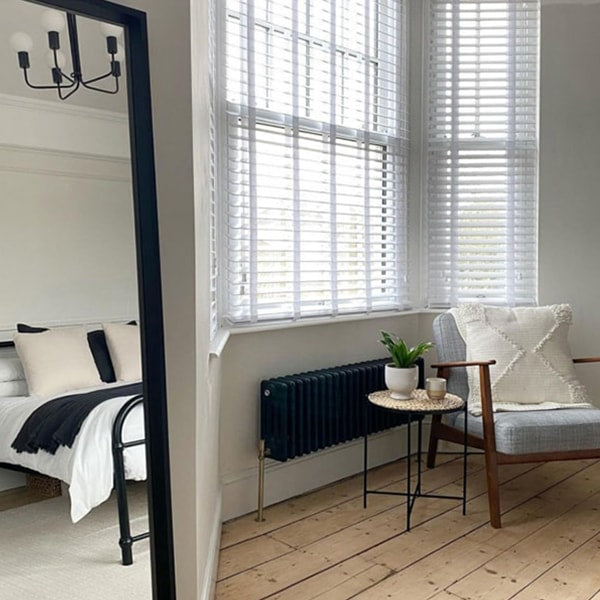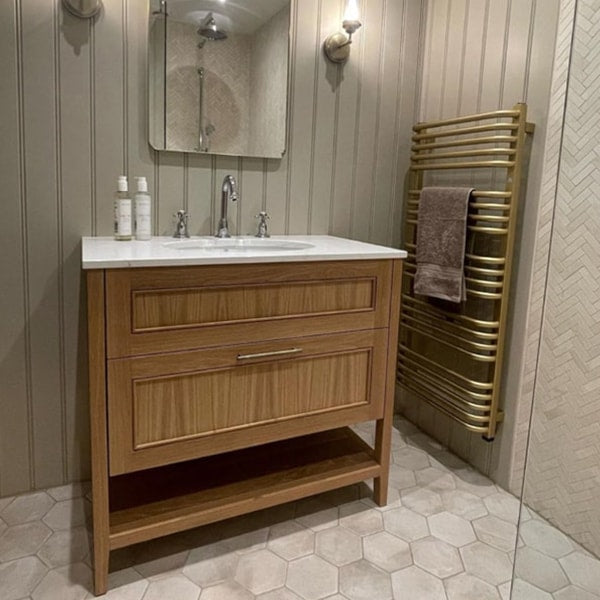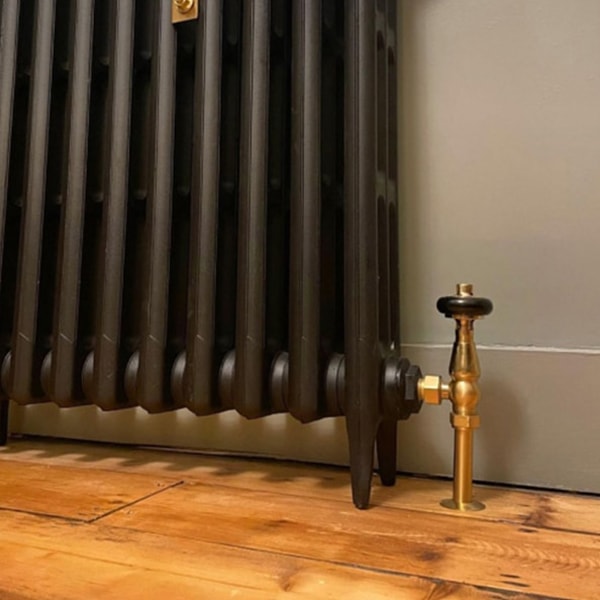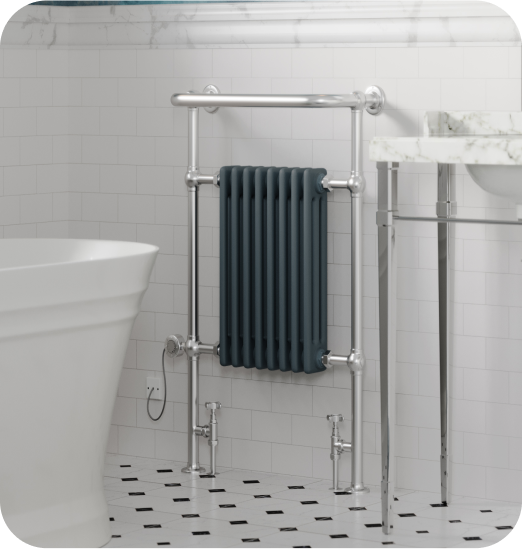Autovents - Radiator Bleed Valve Non Replaceable Cartridge 2 Pack
Product code: 45730
Summary
- Aladdin Autovents automatically bleed air and improve efficiency of radiators, heating systems and underfloor heating networks.
- No need to manually bleed radiators
- Keeps radiators and heating systems fully heat generating and efficient
- Drains air from underfloor heating networks
- Reduces heating costs
- Avoids tenants calling out service engineers just to vent radiators
- Aladdin Autovents are loved by homeowners and landlords.
- They offer a stylish and efficient alternative to having to manually expel air from radiators.
- Aladdin Autovents improve overall heating system efficiency. A standard radiator with just 2” of air can be up to 75% inefficient.

Benefits
Aladdin Autovents save energy, keeps radiators hot to top,reduce corrosion and system noise, and dispense with the need for radiator keys.Landlords like them:
As they reduce the risk of damage caused to systems by tenants failing to bleed air from radiators, as well as the cost of call-outs from those tenants who call out service engineers when air builds in a radiator.
For installed “problem” radiators:
Often systems have a problem radiator in which air collects; most often the towel rail. The symptoms are a cold top bar and the noise of bubbling water. The correct Aladdin product (check the thread size of the radiator) can be installed without draining the system. Just shut off the two water valves, release the pressure in the radiator via the existing manual vent, and use a spanner to take out either the manual vent or the blanking plug before installing the Aladdin valve. Open the water valves and the radiator will then bleed itself.
For new installations:
An increasing number of professionals believe Aladdin’s Hygroseal™ products more than pay for themselves in time-saved in new installations. The installation of new or replacement radiators traditionally has required the time consuming task of running from radiator to radiator to bleed air out as the system refills. Further, water out of the tap contains about 17% air by volume which separates naturally within the system over time and, in a system without Aladdin’s valves, would necessitate the regular bleeding of radiators for the first two weeks of operation at least. Some installers now fit Aladdin’s products on every radiator they fit to save time and money.
Although a perfectly designed and engineered central heating system should not collect air from outside the closed system:
- New water out of the tap contains about 17% absorbed air by volume, which must be drained off from a closed central heating system as and when it separates;
- Not all systems were perfectly designed in the first place, and many systems have been adapted with, e.g. new radiators fitted;
- Many plumbers think that some compression and press-fit plastic fittings can suck in air on the suction side of the pump;
- Corrosion in the system, e.g. inside pressed steel radiators, can result in the formation of gasses.
Fitting Aladdin Autovents helps by automatically eliminating gas and air from radiators which increases the efficiency of central heating systems from two perspectives:
- Fitting Autovents extends the effective life of systems components: Autovents automatically bleed air and gasses from radiators which reduces corrosion and its consequence, the formation of sludge, which in turn extend the life of pumps, automatic valves, etc.
- Because fitting Autovents reduces the volume of air/gas in radiators it helps maintain their thermal efficiency, therefore reducing the fuel requirement.

FAQ's
How do I find out the size of my radiator tapping?
With a 1/2" BSP thread, the threaded hole in the tapping at the top of the radiator is approximately 20mm diameter - you should be able to fit your index finger in the tapping. The plug screwed in to the tapping will either be a chrome hexagonal valve, or a 'plug' with a square cavity in it. If you are uncertain or for smaller tappings please contact your radiator's manufacturer.
Can I fit Autovents to a new system?
Yes, on newly installed closed systems there will be a small pressure drop over the first 2 weeks or so as dissolved air separates from the fresh water (around 17% by volume), but any further pressure drop would be due to loss of system water (leaks). Some installers are priming a newly installed system to about 10% more than its operating pressure to compensate on a system fitted with Autovents.
What if the Hygroscopic™ Autovent is not venting?
The first time radiators fitted with these Hygroscopic™ Autovents are filled the air hisses out until water hits the hygroscopic washers and then they seal (you will often see a small 'bubble' of water after the first fill). If more air/gas builds up in the radiator, it will not escape until the hygroscopic washers have dried a little and have shrunk enough for gas/air to escape. The time it takes for the hygroscopic washers to dry and shrink varies according to ambient temperature and humidity: see the table in the Technical Details on the Product Page. So please, give this valve time to dry, before contacting us.
Can I vent the Hygroscopic™ Autovent manually?
Yes. Cartridge version: by loosening the cartridge slowly until you can hear gas/air escaping. Cartridge-free version: by using a spanner to loosen the whole valve slowly until you can hear gas/air escaping.
Air collecting in a radiator can be an early indication of a leak in the central heating system. Should I be worried that fitting an Autovent will mean that I spot a leak later?
- On a pressurised system: Air can enter the system through micro-gaps in joints etc., without a leak, but in some cases a leak could lead to air collecting in one radiator, and in those cases fitting an Autovent might delay the identification of a leak. On such systems, NLB recommends that Autovents should be fitted to installed radiators that have a history of collecting air, and only after a careful inspection of the system has not identified any leak.
- On a header-tank system: After the air absorbed in the water has separated, the best early indicator of a leak is a drop in pressure of the system, and an Autovent should, if anything, lead to a faster drop in pressure so an even earlier indication of a leak.
When do I know when to replace my Hygroseal cartridge?
If after a minimum of 5 years, the radiator starts getting cold at the top, the cartridge may require replacing in order to continue venting automatically. It is worth manually venting in case it is simply a case of the radiator running cool for a long period, and then seeing if the valve starts venting automatically again.
Can I fit the valve to a piping 'spur' at a system high - point?
Yes, provided the temperature of the piping allows the valve to operate at 35°C for the Hygroseal vent.
Does the Autovent work on Closed and Open systems?
Yes, on newly installed closed systems there will be a small pressure drop over the first 2 weeks or so as dissolved air separates from the fresh water (around 17% by volume) , but any further pressure drop would be due to loss of system water (leaks). Some installers are priming a newly installed system to about 10% more than its operating pressure to compensate on a system fitted with Autovents.
On a Closed system will fitting automatic vents cause the pressure to drop to zero and the boiler stop operating?
The answer is linked to the above - continual venting will be due to new air entering the system (through micro-gaps in joints etc.). Once the fresh water has vented its 17% of absorbed air the volume of water cannot further reduce in size - so if you still experience pressure drop it's due to water loss, i.e. a leak, which will require to be cured.
Can the valves work on negative pressure systems?
On about 1 in 400 systems air may be drawn in to the system where either (a) there is a radiator close to the suction side of the pump or, (b) where a radiator is higher than the water tank, in which case when the pump stops running a vacuum forms (e.g. in loft conversions).The Hygroseal valve has a semi-one way valve fitted already as standard, and will work on negative pressure systems.
Don't all automatic de-aeration valves leak?
No. Aladdin Autovents do not leak. They are guaranteed to operate for 3 years, and guaranteed leak-free for life. They contain a patented mechanical valve that positively closes when water gets to the internal mechanism of the valve. The Hygroseal™ range has a 5 year replacement guarantee.
Can corrosion inhibitors be used with an Autovent?
Yes. Fitting the Autovent should reduce the need for corrosion inhibitors as all your radiators will be free of air, but we do recommend their use because corrosion leads to further gas collecting in the radiators. To allow inhibitors to be used ensure at least one radiator still has a manual vent plug fitted at the opposite end to an Autovent, as this will allow the inhibitor to be injected.
Can leak-stop products be used with the Autovent?
Leak-stop products can jam valves in certain circumstances. We do not recommend their use.
Downloads
Autovent Brochure 2019Need help calculating the heat output for your room?
Guarantee Length: 5 Years
Collection: Autovents
Colour: Chrome
Heat Source: Central Heated/Hot Water
Material: Brass
Product Assurances: CE Marked,5 Years
SKU HV30-2
GTIN:5060123340280
Dry Mass (kg):0.08kg
Width:0mm
- Free delivery options (UK Mainland, Northern Ireland/Highlands/Islands)
- Next working day delivery options (selected products & locations)
- We deliver between 8am and 6pm
- Contact us to delay delivery/request a specific day
- Limitless (that's right, no time limit!) returns
- Free of charge: either we will collect/send a returns label, or we'll refund your postage costs.
- Returns (for reasons other than damage or faults) can only be accepted if the item is returned in the original packaging and has not been fitted or used in any way.
- Whilst all our products pass strict quality standards, on very rare occasions, you may find an item arrives damaged. We ask that when you receive your order, you inspect the packaging before signing and note any damage when signing for it or refuse the delivery, with damage as the reason. Please contact us if you have any issues.
- If you find damage after you have signed for your delivery, please contact us with images of the damage as soon as possible.
- Once the damage has been reported, we'll either replace the item completely free of charge or refund you in full.
-
How can I contact you?
You can message us on live chat. We aim to reply in one minute, between 9am - 5:30pm. After 5:30pm, we'll create a ticket and get back to you asap.
-
Where do you deliver?
We deliver to the whole of the UK and Northern Ireland - including the highlands and islands.
We are currently unable to offer international delivery. However, you can place an order for collection and arrange to have a courier of your choice collect the order and delivery it to you.
-
Who will deliver my order?
Our two primary couriers for UK Radiators products are Royal Mail and DX Express. Your courier will depend on the size and weight of the items on your order.
For example a pair of valves will be sent to you with Royal Mail, whereas a Column radiator will be sent with DX.
Tracking is provided for all orders dispatched from our warehouse.
If you order a Terma product, your item(s) will be coming directly from their warehouse.
The couriers they use are Stop Start and Parcelforce, and tracking is provided where possible.
-
Can I choose a specific time or day for my delivery?
If, for any reason, you would like to delay your delivery, please contact one of the customer service team as soon as you have placed your order, who will be able to assist you.
We are currently unable to request specific delivery time slots with our couriers.
Some of our couriers will advise you of a smaller time slot for your delivery, but unless otherwise stated, deliveries can take place any time between 7am and 7pm.
-
Can I upgrade my delivery?
We offer the option to upgrade delivery to either Two Man VIP delivery to a room of your choice, or Next Working Day delivery. Upgrade availability is dependant on the size of product and delivery location. Once dispatched, your order is sent on the delivery service chosen at checkout. This cannot be changed after dispatch.
-
Can I send orders to a different address?
You can change the shipping address to a different address if your billing address matches what's registered against your payment method.
However, this can only be done when placing the order.
We are unable to change the delivery address after the order has been placed and dispatched. In this instance, the order would need to be cancelled and refunded, and a new order placed with the correct delivery address.
Watts & BTUs (British Thermal Units) Explained
What is a Watt?
Watts are our main unit of energy/power in the UK, commonly associated with lightbulbs and Home Energy performance certificates (EPCs).
What is a BTU?
BTUs are the unit of measurement used to portray a radiators heat output and a rooms heating requirement. 1 Watt is equal to 3.41 BTUs.
Why are they important?
We buy radiators to heat our homes, right? So, we need a way of knowing if a radiator is powerful enough to heat the room that we are shopping for - Watts and BTUs provide us with a value that makes its easier to compare radiators and ultimately choose the right one for our heating requirement.
Need help figuring out how much heat your room needs?
Our fast and easy-to-use BTU calculator can help you:
- Work out a heating requirement value (in BTUs & Watts) for your room
- Show you in-stock radiator recommendations that can fulfil this heat requirement
Delta (Δ) Ratings Explained
What is a Delta (Δ) Rating?
When discussing heat outputs, the Delta rating is the difference between the temperature of the water inside the heating system and the desired temperature of the room.
What does the value represent?
In simple terms, this value is about heat loss. Heating a room only works, if the radiator output exceeds the heat loss of the room.
We use this calculation to make it easy to choose a radiator that will have a heat output that exceeds the heat loss of the room when connected to your heating system type.
If you don't know the room heat loss, you can use our calculator to find out.
What Delta Rating should I use?
- Δ50 = Gas or oil boiler with a flow temperature of around 75°C and a return temperature of around 65°C.
- Δ30 = Low temperature systems e.g heat pumps.
Summary
- Aladdin Autovents automatically bleed air and improve efficiency of radiators, heating systems and underfloor heating networks.
- No need to manually bleed radiators
- Keeps radiators and heating systems fully heat generating and efficient
- Drains air from underfloor heating networks
- Reduces heating costs
- Avoids tenants calling out service engineers just to vent radiators
- Aladdin Autovents are loved by homeowners and landlords.
- They offer a stylish and efficient alternative to having to manually expel air from radiators.
- Aladdin Autovents improve overall heating system efficiency. A standard radiator with just 2” of air can be up to 75% inefficient.

Benefits
Aladdin Autovents save energy, keeps radiators hot to top,reduce corrosion and system noise, and dispense with the need for radiator keys.Landlords like them:
As they reduce the risk of damage caused to systems by tenants failing to bleed air from radiators, as well as the cost of call-outs from those tenants who call out service engineers when air builds in a radiator.
For installed “problem” radiators:
Often systems have a problem radiator in which air collects; most often the towel rail. The symptoms are a cold top bar and the noise of bubbling water. The correct Aladdin product (check the thread size of the radiator) can be installed without draining the system. Just shut off the two water valves, release the pressure in the radiator via the existing manual vent, and use a spanner to take out either the manual vent or the blanking plug before installing the Aladdin valve. Open the water valves and the radiator will then bleed itself.
For new installations:
An increasing number of professionals believe Aladdin’s Hygroseal™ products more than pay for themselves in time-saved in new installations. The installation of new or replacement radiators traditionally has required the time consuming task of running from radiator to radiator to bleed air out as the system refills. Further, water out of the tap contains about 17% air by volume which separates naturally within the system over time and, in a system without Aladdin’s valves, would necessitate the regular bleeding of radiators for the first two weeks of operation at least. Some installers now fit Aladdin’s products on every radiator they fit to save time and money.
Although a perfectly designed and engineered central heating system should not collect air from outside the closed system:
- New water out of the tap contains about 17% absorbed air by volume, which must be drained off from a closed central heating system as and when it separates;
- Not all systems were perfectly designed in the first place, and many systems have been adapted with, e.g. new radiators fitted;
- Many plumbers think that some compression and press-fit plastic fittings can suck in air on the suction side of the pump;
- Corrosion in the system, e.g. inside pressed steel radiators, can result in the formation of gasses.
Fitting Aladdin Autovents helps by automatically eliminating gas and air from radiators which increases the efficiency of central heating systems from two perspectives:
- Fitting Autovents extends the effective life of systems components: Autovents automatically bleed air and gasses from radiators which reduces corrosion and its consequence, the formation of sludge, which in turn extend the life of pumps, automatic valves, etc.
- Because fitting Autovents reduces the volume of air/gas in radiators it helps maintain their thermal efficiency, therefore reducing the fuel requirement.

FAQ's
How do I find out the size of my radiator tapping?
With a 1/2" BSP thread, the threaded hole in the tapping at the top of the radiator is approximately 20mm diameter - you should be able to fit your index finger in the tapping. The plug screwed in to the tapping will either be a chrome hexagonal valve, or a 'plug' with a square cavity in it. If you are uncertain or for smaller tappings please contact your radiator's manufacturer.
Can I fit Autovents to a new system?
Yes, on newly installed closed systems there will be a small pressure drop over the first 2 weeks or so as dissolved air separates from the fresh water (around 17% by volume), but any further pressure drop would be due to loss of system water (leaks). Some installers are priming a newly installed system to about 10% more than its operating pressure to compensate on a system fitted with Autovents.
What if the Hygroscopic™ Autovent is not venting?
The first time radiators fitted with these Hygroscopic™ Autovents are filled the air hisses out until water hits the hygroscopic washers and then they seal (you will often see a small 'bubble' of water after the first fill). If more air/gas builds up in the radiator, it will not escape until the hygroscopic washers have dried a little and have shrunk enough for gas/air to escape. The time it takes for the hygroscopic washers to dry and shrink varies according to ambient temperature and humidity: see the table in the Technical Details on the Product Page. So please, give this valve time to dry, before contacting us.
Can I vent the Hygroscopic™ Autovent manually?
Yes. Cartridge version: by loosening the cartridge slowly until you can hear gas/air escaping. Cartridge-free version: by using a spanner to loosen the whole valve slowly until you can hear gas/air escaping.
Air collecting in a radiator can be an early indication of a leak in the central heating system. Should I be worried that fitting an Autovent will mean that I spot a leak later?
- On a pressurised system: Air can enter the system through micro-gaps in joints etc., without a leak, but in some cases a leak could lead to air collecting in one radiator, and in those cases fitting an Autovent might delay the identification of a leak. On such systems, NLB recommends that Autovents should be fitted to installed radiators that have a history of collecting air, and only after a careful inspection of the system has not identified any leak.
- On a header-tank system: After the air absorbed in the water has separated, the best early indicator of a leak is a drop in pressure of the system, and an Autovent should, if anything, lead to a faster drop in pressure so an even earlier indication of a leak.
When do I know when to replace my Hygroseal cartridge?
If after a minimum of 5 years, the radiator starts getting cold at the top, the cartridge may require replacing in order to continue venting automatically. It is worth manually venting in case it is simply a case of the radiator running cool for a long period, and then seeing if the valve starts venting automatically again.
Can I fit the valve to a piping 'spur' at a system high - point?
Yes, provided the temperature of the piping allows the valve to operate at 35°C for the Hygroseal vent.
Does the Autovent work on Closed and Open systems?
Yes, on newly installed closed systems there will be a small pressure drop over the first 2 weeks or so as dissolved air separates from the fresh water (around 17% by volume) , but any further pressure drop would be due to loss of system water (leaks). Some installers are priming a newly installed system to about 10% more than its operating pressure to compensate on a system fitted with Autovents.
On a Closed system will fitting automatic vents cause the pressure to drop to zero and the boiler stop operating?
The answer is linked to the above - continual venting will be due to new air entering the system (through micro-gaps in joints etc.). Once the fresh water has vented its 17% of absorbed air the volume of water cannot further reduce in size - so if you still experience pressure drop it's due to water loss, i.e. a leak, which will require to be cured.
Can the valves work on negative pressure systems?
On about 1 in 400 systems air may be drawn in to the system where either (a) there is a radiator close to the suction side of the pump or, (b) where a radiator is higher than the water tank, in which case when the pump stops running a vacuum forms (e.g. in loft conversions).The Hygroseal valve has a semi-one way valve fitted already as standard, and will work on negative pressure systems.
Don't all automatic de-aeration valves leak?
No. Aladdin Autovents do not leak. They are guaranteed to operate for 3 years, and guaranteed leak-free for life. They contain a patented mechanical valve that positively closes when water gets to the internal mechanism of the valve. The Hygroseal™ range has a 5 year replacement guarantee.
Can corrosion inhibitors be used with an Autovent?
Yes. Fitting the Autovent should reduce the need for corrosion inhibitors as all your radiators will be free of air, but we do recommend their use because corrosion leads to further gas collecting in the radiators. To allow inhibitors to be used ensure at least one radiator still has a manual vent plug fitted at the opposite end to an Autovent, as this will allow the inhibitor to be injected.
Can leak-stop products be used with the Autovent?
Leak-stop products can jam valves in certain circumstances. We do not recommend their use.
Downloads
Autovent Brochure 2019Need help calculating the heat output for your room?
Guarantee Length: 5 Years
Collection: Autovents
Colour: Chrome
Heat Source: Central Heated/Hot Water
Material: Brass
Product Assurances: CE Marked,5 Years
SKU HV30-2
GTIN:5060123340280
Dry Mass (kg):0.08kg
Width:0mm
- Free delivery options (UK Mainland, Northern Ireland/Highlands/Islands)
- Next working day delivery options (selected products & locations)
- We deliver between 8am and 6pm
- Contact us to delay delivery/request a specific day
- Limitless (that's right, no time limit!) returns
- Free of charge: either we will collect/send a returns label, or we'll refund your postage costs.
- Returns (for reasons other than damage or faults) can only be accepted if the item is returned in the original packaging and has not been fitted or used in any way.
- Whilst all our products pass strict quality standards, on very rare occasions, you may find an item arrives damaged. We ask that when you receive your order, you inspect the packaging before signing and note any damage when signing for it or refuse the delivery, with damage as the reason. Please contact us if you have any issues.
- If you find damage after you have signed for your delivery, please contact us with images of the damage as soon as possible.
- Once the damage has been reported, we'll either replace the item completely free of charge or refund you in full.
-
How can I contact you?
You can message us on live chat. We aim to reply in one minute, between 9am - 5:30pm. After 5:30pm, we'll create a ticket and get back to you asap.
-
Where do you deliver?
We deliver to the whole of the UK and Northern Ireland - including the highlands and islands.
We are currently unable to offer international delivery. However, you can place an order for collection and arrange to have a courier of your choice collect the order and delivery it to you.
-
Who will deliver my order?
Our two primary couriers for UK Radiators products are Royal Mail and DX Express. Your courier will depend on the size and weight of the items on your order.
For example a pair of valves will be sent to you with Royal Mail, whereas a Column radiator will be sent with DX.
Tracking is provided for all orders dispatched from our warehouse.
If you order a Terma product, your item(s) will be coming directly from their warehouse.
The couriers they use are Stop Start and Parcelforce, and tracking is provided where possible.
-
Can I choose a specific time or day for my delivery?
If, for any reason, you would like to delay your delivery, please contact one of the customer service team as soon as you have placed your order, who will be able to assist you.
We are currently unable to request specific delivery time slots with our couriers.
Some of our couriers will advise you of a smaller time slot for your delivery, but unless otherwise stated, deliveries can take place any time between 7am and 7pm.
-
Can I upgrade my delivery?
We offer the option to upgrade delivery to either Two Man VIP delivery to a room of your choice, or Next Working Day delivery. Upgrade availability is dependant on the size of product and delivery location. Once dispatched, your order is sent on the delivery service chosen at checkout. This cannot be changed after dispatch.
-
Can I send orders to a different address?
You can change the shipping address to a different address if your billing address matches what's registered against your payment method.
However, this can only be done when placing the order.
We are unable to change the delivery address after the order has been placed and dispatched. In this instance, the order would need to be cancelled and refunded, and a new order placed with the correct delivery address.





